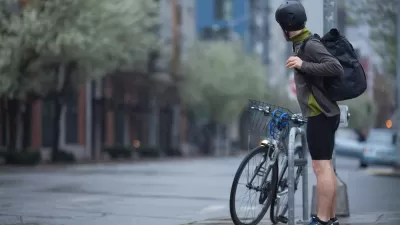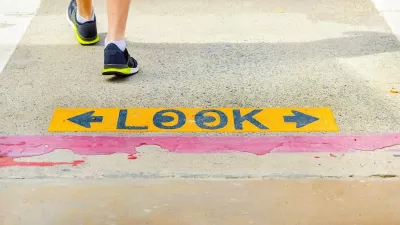With many states witnessing a rise in pedestrian fatalities, David M Nelson asks: "Where is the public outcry to improve safety?" With pedestrians often blamed for such incidents, he argues new laws dealing with pedestrian-vehicle crashes are needed.
Why is it that defensless pedestrians are often the first to be blamed for collisions with vehicles? As Nelson explains, this hasn't always been the case. "In the early 1900s, cars and their drivers were depicted in editorials, cartoons and accident reports as reckless murderers....What changed, mid-century, was that the highway lobby essentially took over the reporting of pedestrian and cyclists harmed by drivers; unsurprisingly, they changed the voice of coverage to presume the innocence of drivers."
Nelson spreads the blame to the American legal system which includes "few laws motivate law enforcement to consider killing a pedestrian as a crime."
Lastly, he points a finger at the media for their portrayal of such incidents. "First and foremost, underlying all of the poor media coverage is what I call the 'Accident Axiom.' This is the widely-held (but almost never-question) belief that accidents are an unavoidable and innocent consequence of modern motorized society. The assumption here is that crashes not involving excessive speed, alcohol, or gross negligence are presumably the fault of no one, but an unfortunate systemic fluke."
"This axiom has two corollaries: the Inherent Risk Corollary and the Reckless Driver Corollary. The former states that in this world of unavoidable accidents, pedestrians and cyclists are senselessly putting themselves in harm’s way by traversing concrete and asphalt. If they get hit, it is a deserved consequence of their poor decision making. And the latter states that those rare instances when a driver is at fault, it is the result of that driver being a reckless and careless individual, a deviant member of society. All blame is attributed to the individuals involved. The road network and driving culture are given immunity."
Solutions to this conundrum include: getting a Vulnerable Users Law introduced into your state legislature, lowering the speed of traffic, and convincing media outlets to change the way they report on pedestrian deaths.
FULL STORY: Walking is Not a Crime: Questioning the Accident Axiom

Trump Administration Could Effectively End Housing Voucher Program
Federal officials are eyeing major cuts to the Section 8 program that helps millions of low-income households pay rent.

Planetizen Federal Action Tracker
A weekly monitor of how Trump’s orders and actions are impacting planners and planning in America.

Ken Jennings Launches Transit Web Series
The Jeopardy champ wants you to ride public transit.

Washington Legislature Passes Rent Increase Cap
A bill that caps rent increases at 7 percent plus inflation is headed to the governor’s desk.

From Planning to Action: How LA County Is Rethinking Climate Resilience
Chief Sustainability Officer Rita Kampalath outlines the County’s shift from planning to implementation in its climate resilience efforts, emphasizing cross-departmental coordination, updated recovery strategies, and the need for flexible funding.

New Mexico Aging Department Commits to Helping Seniors Age ‘In Place’ and ‘Autonomously’ in New Draft Plan
As New Mexico’s population of seniors continues to grow, the state’s aging department is proposing expanded initiatives to help seniors maintain their autonomy while also supporting family caregivers.
Urban Design for Planners 1: Software Tools
This six-course series explores essential urban design concepts using open source software and equips planners with the tools they need to participate fully in the urban design process.
Planning for Universal Design
Learn the tools for implementing Universal Design in planning regulations.
Heyer Gruel & Associates PA
Ada County Highway District
Institute for Housing and Urban Development Studies (IHS)
City of Grandview
Harvard GSD Executive Education
Toledo-Lucas County Plan Commissions
Salt Lake City
NYU Wagner Graduate School of Public Service





























